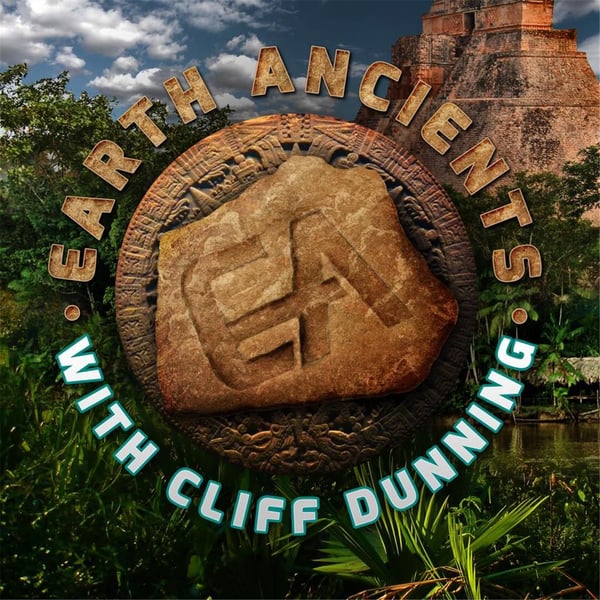Andre Chaisson: Telepylos, from Myth to Reality
Earth Ancients
Cliff Dunning
4.4 • 1.5K Ratings
🗓️ 28 June 2025
⏱️ 81 minutes
🧾️ Download transcript
Summary
Spanning approximately 80 square kilometers, the site lies at a depth of 250 meters between Sicily and Malta and features striking geometric formations. A central mound, comparable in scale to the Great Pyramid of Giza, and an encircling canal—529 meters wide and 50 meters deep—underscore the engineering sophistication of this ancient settlement. These features suggest a city of immense scale and importance, potentially serving as a waypoint for ancient mariners. Through a recalibration of sea-level models using datasets from EMODnet and GEBCO, this study proposes that the Mediterranean basin, isolated from the Atlantic during the Last Glacial Maximum (LGM), experienced a localized sea-level drop to approximately -250 meters, exposing vast landscapes suitable for human settlement. This stable plateau, lasting nearly 3,000 years, likely provided the conditions for Telepylos and similar civilizations to thrive before a gradual sea-level rise submerged the city by 8,600 BC. Unlike Atlantis, Telepylos’s submersion was not sudden but marked by centuries of encroachment as nature slowly reclaimed the city. The findings challenge conventional paradigms about LGM sea levels and ancient Mediterranean civilizations.
André Chaisson is a seasoned civil engineering designer with over 25 years of CAD experience, including five years as a senior designer shaping large-scale infrastructure projects. With a knack for crafting plans and maps—honed through work on urban designs, municipal systems, and bathymetric surveys—he built a career grounded in pragmatism. Yet beneath the surface, a lifelong fascination with the mysteries of the past, from Atlantis to the Great Pyramids, simmered quietly. Self-taught with years of college education, including naval architecture, he’s now channeling his skills into a bold new chapter. Already, he’s uncovered the lost city of Telepylos, a discovery he’s determined to bring to the world’s attention. With sights set on revealing Atlantis next, André is on a mission to rewrite the history of humankind. Humble yet driven, he aims to spark a renaissance in archaeology, blending meticulous expertise with an adventurer’s heart to inspire future exploration.
https://grahamhancock.com/author/andre-chaisson/
Become a supporter of this podcast: https://www.spreaker.com/podcast/earth-ancients--2790919/support.
Transcript
Click on a timestamp to play from that location
| 0:00.0 | Well, we have a good show today. Of course, we always have a good show, right? I mean, you're not sitting here listening if we weren't producing good material. And I hope you do enjoy Earth Ancients. And I have to say, if you've been following us on social media, we have a great new discovery in the Mediterranean Ocean. |
| 0:40.2 | And this is a place called Telphilos. And we're going to talk a great deal about underwater |
| 0:47.0 | discoveries. What makes today's program a perfect fit for Earth ancients in our theme? |
| 0:53.8 | Our theme is unknown ancient civilizations. |
| 0:57.0 | And the fact that our history is not really accurate. It's very, very inaccurate, really. It is |
| 1:06.3 | inaccurate at all. And you can't talk to archaeologists about that. You can't say to them, |
| 1:11.6 | you know, look, your research is not valid, so forth and so on. Because, look, thousands and |
| 1:17.0 | thousands of archaeologists and anthropologists have done a good job of giving us a sense of |
| 1:22.4 | history according to their view of it. But what is hard for me, and many of the guests we have here on the podcast, |
| 1:32.0 | is the fact that academia only goes so far. |
| 1:35.6 | They will not consider advanced civilizations before Sumeria, |
| 1:39.9 | before dynastic Egyptians, |
| 1:42.4 | before certain civilizations around the world. |
| 1:46.3 | And people like Graham Hancock, Robert Temple, Michael Krimo, |
| 1:52.0 | and the list goes on and on and on, provided us with a consideration for extreme antiquity. |
| 2:00.3 | We have Michael Kremel on the program, and he's pulling up artifacts that are, you know, |
| 2:05.6 | millions of years old, sophisticated silverware, pots, jewelry, dolls, and figurines. |
| 2:14.6 | And in fact, it goes beyond that. |
| 2:16.8 | It goes into the physical remains of humans. |
| 2:20.5 | And there's many, many examples of homo sapiens sapiens being found in very, very deep layers of sediment that are dated to over a million years. |
| 2:34.1 | Well, if you bring that up to current archaeologists and |
| 2:38.7 | geologists, they think it's a scam or it's an anomaly. Well, I don't believe that's true. I've had a |
... |
Please login to see the full transcript.
Disclaimer: The podcast and artwork embedded on this page are from Cliff Dunning, and are the property of its owner and not affiliated with or endorsed by Tapesearch.
Generated transcripts are the property of Cliff Dunning and are distributed freely under the Fair Use doctrine. Transcripts generated by Tapesearch are not guaranteed to be accurate.
Copyright © Tapesearch 2025.

